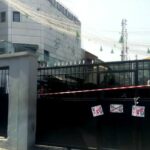
Nigeria has a potential of 3.14 million hectares of irrigation land, but at present, the actual irrigated area developed across the country is 169,718 hectares, the Federal Government has said.
It, therefore, implies that the actual irrigated area in Nigeria currently is 5.4 per cent, leaving over 94 per cent or 2.97 million hectares of farmland without irrigation nationwide.
Irrigation simply means the supply of water to land or crops to help growth, typically by means of channels.
A document obtained by our correspondent in Abuja on Sunday from the Federal Ministry of Water Resources on infrastructure development by the FMWR between 2016 and 2022, indicated that though the government was making efforts to irrigate more areas, a lot of farmlands still lacked irrigation.
Under the section titled, ‘irrigation sub-sector,’ the Minister of Water Resources, Suleiman Adamu, explained that an irrigation programme, tagged “National Irrigation Programme 2016 – 2030” was being implemented.
He said, “The programme aims to reduce dependency on rain-fed, boost agriculture production and support the nation’s quest for food security.
“Nigeria has a potential of 3.14 million hectares of irrigation land. Out of this, 500,000Ha is planned for development by FGN (Federal Government of Nigeria) by 2030.
“Private sector and state governments are expected to develop an additional 1,000,000Ha of irrigation land and associated infrastructure by 2030. At present, the actual irrigated area developed is 169,718 hectares.”
Adamu further stated that in June 2014, the World Bank approved the International Development Association credit of $495m for Nigeria to fund what later came to be known as the “Transforming Irrigation Management in Nigeria” project.
He stated in the document that Nigeria’s counterpart funding for the project was $44m which is equivalent to 8.88 per cent of the World Bank IDA credit.
He said, “TRIMING’s objective is to improve access to irrigation and drainage services, strengthen institutional arrangements for integrated water resources management and agriculture service delivery across four selected large scale public schemes in Northern Nigeria.
“They include the Bakolori Irrigation Scheme in Zamfara State; Middle Rima Irrigation Scheme in Sokoto State; Kano River Irrigation Scheme and Hadejia Valley Irrigation Scheme in Jigawa State.”
Adamu, however, stated that nine irrigation projects had been completed by the Federal Government between 2016 and 2022.
He named the projects to include the 1,200Ha Sabke Irrigation Project that was completed in 2018; Shagari Irrigation Project, 220Ha, 2018; Sepeteri Irrigation Project, 180Ha, 2018; Ejule-Ojebe Irrigation Project, 50Ha, 2018; and Mamu Akwa Drainage and Land Reclamation, 180Ha, 2019.
Others include the promotion of gender/women participation in irrigated agriculture, 10Ha, 2021; Centre Pivot System Irrigation, 2,880Ha, 2021; Obinda Drainage Project, Phase I, 250Ha, 2021; as well as the supply and installation of tubewells and water pumps, Phase I, 1,000Ha, 2022.
The minister stated in the report that two irrigation projects were partially completed. They include the Middle Rima Irrigation Project, Phase I, 3,070Ha, 2021; and Gari Irrigation Project, sector 1-6 completed, 2,114Ha, 2022.





